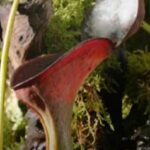As an Amazon Associate, this site earns commissions from qualifying purchases. For more details, click here.
You might have seen nepenthes hanging from baskets and they make quit a pretty sight. The good news is you do not need to be an expert gardener to learn how to hang pitcher plants. If you have never done this before, you are in the right spot as this guide is specifically to help you. As you will see, the steps are easy to follow.
Pitcher plants benefit from being placed in hanging baskets because it is easier to catch flying insects. You can hang pitcher plants anywhere outdoors as long as there is enough sunlight and temperature is 60-85 F.
Where to Hang Pitcher Plants?
The best place to hang pitcher plants is a sunny location where it can get 6-8 hours of sunlight. These plants prefer a temperature range of 60-85 degrees (15-30 C), so anywhere outdoors or by a sunny window is a good idea.
You can hang the plant from a basket or a pot. For example, you can plant your nepenthes in Swim Duck Pots and place them on a windowsill, preferably south facing for maximum sunlight exposure. Pitcher plant colors become more intense when exposed to light, so you will know if it is getting enough or not.
While pitcher plants prefer the 60-85 F range, it should be fine in 90 degree temperatures for short periods. You should only shade the plant if the leaves start to turn crispy due to the heat. If the pitcher plant naturally grows in your location, it should hold up.
You can use any basket, pot or container as long as it is large enough for the plant. You can hang the pot outdoors or indoors as a houseplant it is up to you. The important thing is to ensure the plant receives enough light.
Soil, Water and Drainage
All hanging pitcher plants require poor soil with good drainage. Water the plant so the soil is always moist. This is essential to keep the plant alive.
Mix peat moss and perlite equally (1:1) or long sphagnum moss and silica sand (also 1:1) . You can also use orchid mix or charcoal. Never use rich, fertilized soil on pitcher plants or any carnivorous plant for that matter.
Keep the soil moist from spring to fall and never let the soil dry. Water as often as necessary, but take care not to over water the plant. You can use a moisture meter to check the moisture level of the soil.
Hanging pitcher plants should not sit in several inches of water. It is better to water from the top and let it flow through to the soil. This is why proper drainage is important.
You should only use distilled water, reverse osmosis water or rainwater. Never use tap water because the chemicals are too harsh for plants. Continuous use of tap water will introduce unwelcome elements in the soil. This can cause permanent damage to your hanging pitcher plants.
Humidity For Hanging Pitcher Plants
Pitcher plants naturally grow in bogs, swamps and other warm, humid locations. When hanging nepenthes or sarracenia, you have to try and replicate this for optimum growth. Humidity is essential for growth and without it the plant will not last.
Humidity requirements vary, but most pitcher plants need at least 40%. If you can get the humidity level up to 50% that is better.
Ventilation is also important. Hanging pitcher plants need sufficient air circulation to grow and thrive. Keep this in mind if you are growing pitcher plants in a terrarium or greenhouse. If you are hanging the plant make sure there is enough space around it for air to circulate.
Nutrition and Feeding
Feeding pitcher plants leads to faster growth, stronger resistance to diseases and larger pitchers. During the growth period from late April to October, feed your plant regularly.
Nepenthes can be fed a small insect once or four times a month. Small bugs like ants, mosquitoes, flies, spiders, crickets etc. are suitable. You can also give fish food and mealworms to these plants as well.
The nice thing about pitcher plants is they are very easy to feed. Choose the food and drop it into the pitcher. Do not fill the pitcher with insects, just one is enough. Once you place the food in the pitcher, the plant will consume it.
If you are hanging pitcher plants outdoors, there is no need to give it food. The plant secretes nectar around the pitcher rim and walls, which draws insects to it.
When insects get onto the pitcher, the moisture causes them to fall into the trap. Liquids in the cupped leaves prevent the bug from escaping. Eventually the animal dies from exhaustion or gets drowned in the liquids. Next, the plant releases digestive juices to dissolve the prey and eat it.
The time it takes to digest food will depend on its size. This is why you should only give small insects to these plants. A large cockroach might prove a hard one to crack. This will force the pitcher plant to exert a lot of energy trying to digest it. This could result in more energy going out of the plant than getting in.
When and What to Feed
Outdoor pitcher plants do not need help with feeding. Let the plant catch insects on its own. If your plants are indoors and being kept like a houseplant,, give it bugs or other food.
Live or dead bugs. It does not matter whether the insect is alive or dead. However it is difficult to catch insects so this is not practical. If you do capture a live bug, just put it into the pitcher.
As stated earlier, fish pellets and fish flakes are good options. They are nutritious and easy to find. Crush the flakes and add a bit of water, and the food is ready.
Freeze dried mealworms and bloodworms are often given to carnivorous plants. They are as widely available as fish food and makes feeding easy. For the best value we suggest Hatortempt Mealworms.
When feeding worms to nepenthes, give it small amounts. Too much food at once could overwhelm the plant and prove fatal. While most pitcher plants will do fine with once a month feeding, you can try once a week or every two weeks.
Never give processed food to pitcher plants. Foods made for humans are not suitable for carnivorous plants. Giving cheeseburgers or pizza to nepenthes can cause irreparable harm to it.
Dormancy For Hanging Pitcher Plants
Nepenthes pitcher plants do not go dormant. You should keep the plant in the same environment throughout the year for best results.
Sarracenia pitcher plants require dormancy for 3 to 5 months. Make sure the plant is in a suitable environment before winter arrives.
If your pitcher plant goes dormant, prune leaves and remove dying pitchers before winter. If the plant is native to your region, it should be able to survive the winter and reemerge in the spring.
If you keep hanging pitcher plants indoors, find a cold location for it as winter approaches. You can move it outdoors for the winter, or place it in an unheated section of your home. What is important is that you find a cold enough spot so the plant can go dormant.
You only need to do this if the plant requires dormancy. If yours does not, you can keep the plant in the same setting all year. If you have a hanging sarracenia with growing pitchers, cover it with mulch during winter.
Propagation
The best time to propagate pitcher plants is after it emerges from dormancy. Options include leaf cuttings ,root cuttings and seedlings. This is also the best time to report the plant. Use only poor soil for any cuttings you want to propagate.
Propagation from leaf cuttings is faster compared to seeds. You only need a couple of stems with leaves. Place it in a pot with long sphagnum moss and water it. Grow under artificial light for several hours a day, and after a few weeks you will see growth.
Conclusion
There are many types of pitcher plants, and each has its unique charm. Make sure you buy from a reputable vendor to ensure quality. You should also plan ahead so you can provide the best possible care for hanging pitcher plants.

My fascination with carnivorous plants began many, many years ago with Venus Fly Traps. Now I am more than happy to impart what I know with other enthusiasts and those who are curious about meat eating plants.



